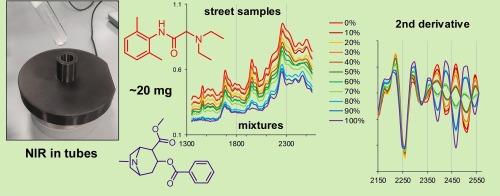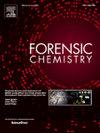在法医鉴定毒品的分析方案中,用便携式近红外检测仪取代颜色检测仪
IF 2.6
3区 医学
Q2 CHEMISTRY, ANALYTICAL
引用次数: 0
摘要
在瞬息万变的毒品市场中,毒品的流行和供应是动态变化的。在荷兰,氯胺酮和各种卡西酮最近越来越流行。对于执法部门来说,快速获得某种物质的初步特征至关重要。首次检测也可作为后续气相色谱-质谱分析确认的质量控制。传统上,这些用途一直使用颜色测试。虽然这些检测方法快速而廉价,但其缺点是只能对少数传统药物产生反应。许多新型精神活性物质 (NPS) 都没有合适的颜色测试。近红外光谱(NIR)是一种快速技术,可提供有机化合物的特征光谱。与颜色测试相比,该技术用途更广,而且通过将参考光谱纳入库,可以更快地适应市场变化。本研究证明了从试管中的 20 毫克子样品中获取高质量近红外光谱的可行性。这是通过玻璃底部扫描试管实现的。在常规分析方案中,这些试管随后通过气相色谱-质谱(GC-MS)进行批量分析。通过近红外光谱分析,516 个案例样本中的阳性结果占 84%,阴性结果占 100%,其中包括对氯胺酮等无法进行颜色测试的物质的鉴定。漏检的假阴性物质主要是库中没有的新物质,这强调了持续更新库的必要性。近红外技术对市场变化的适应性至关重要,可以在新物质出现时将其纳入。这种方法提高了执法部门做出明智决定的能力,有助于起诉过程。本文章由计算机程序翻译,如有差异,请以英文原文为准。

Portable near-infrared detection to replace color tests in an analytical scheme for forensic drug identification
In the ever-changing drug market the popularity and availability of substances is dynamic. In the Netherlands, ketamine and various cathinones have recently seen increased prevalence. It is crucial for law enforcement to quickly obtain an initial indication of the identity of a substance. This first test also serves as quality control for subsequent confirmation with GC–MS analysis. Traditionally, color tests have been used for these purposes. While these tests are quick and inexpensive, they have the disadvantage of reacting only to a few traditional drugs. Suitable color tests are not available for many new psychoactive substances (NPS). Near-infrared (NIR) spectroscopy is a rapid technique that provides a characteristic spectrum for organic compounds. This technique is more versatile than color tests and can adapt more quickly to market changes by incorporating reference spectra into the library. This study demonstrates the feasibility of obtaining a good quality NIR spectrum from a 20 mg sub-sample in a test tube. This was achieved by scanning the test tube through the glass bottom. In the routine analytical scheme, these test tubes were subsequently batchwise analyzed by GC–MS. From the NIR spectra, 84 % true positive and 100 % true negative results were achieved on 516 casework samples, including identification of substances without available color tests like ketamine. Missed false negatives primarily involved new substances absent from the library, emphasizing the need for continuous library updates. NIR’s adaptability to market changes is crucial, allowing the inclusion of new substances as they emerge. This method enhances law enforcement’s ability to make informed decisions, aiding in the indictment process.
求助全文
通过发布文献求助,成功后即可免费获取论文全文。
去求助
来源期刊

Forensic Chemistry
CHEMISTRY, ANALYTICAL-
CiteScore
5.70
自引率
14.80%
发文量
65
审稿时长
46 days
期刊介绍:
Forensic Chemistry publishes high quality manuscripts focusing on the theory, research and application of any chemical science to forensic analysis. The scope of the journal includes fundamental advancements that result in a better understanding of the evidentiary significance derived from the physical and chemical analysis of materials. The scope of Forensic Chemistry will also include the application and or development of any molecular and atomic spectrochemical technique, electrochemical techniques, sensors, surface characterization techniques, mass spectrometry, nuclear magnetic resonance, chemometrics and statistics, and separation sciences (e.g. chromatography) that provide insight into the forensic analysis of materials. Evidential topics of interest to the journal include, but are not limited to, fingerprint analysis, drug analysis, ignitable liquid residue analysis, explosives detection and analysis, the characterization and comparison of trace evidence (glass, fibers, paints and polymers, tapes, soils and other materials), ink and paper analysis, gunshot residue analysis, synthetic pathways for drugs, toxicology and the analysis and chemistry associated with the components of fingermarks. The journal is particularly interested in receiving manuscripts that report advances in the forensic interpretation of chemical evidence. Technology Readiness Level: When submitting an article to Forensic Chemistry, all authors will be asked to self-assign a Technology Readiness Level (TRL) to their article. The purpose of the TRL system is to help readers understand the level of maturity of an idea or method, to help track the evolution of readiness of a given technique or method, and to help filter published articles by the expected ease of implementation in an operation setting within a crime lab.
 求助内容:
求助内容: 应助结果提醒方式:
应助结果提醒方式:


